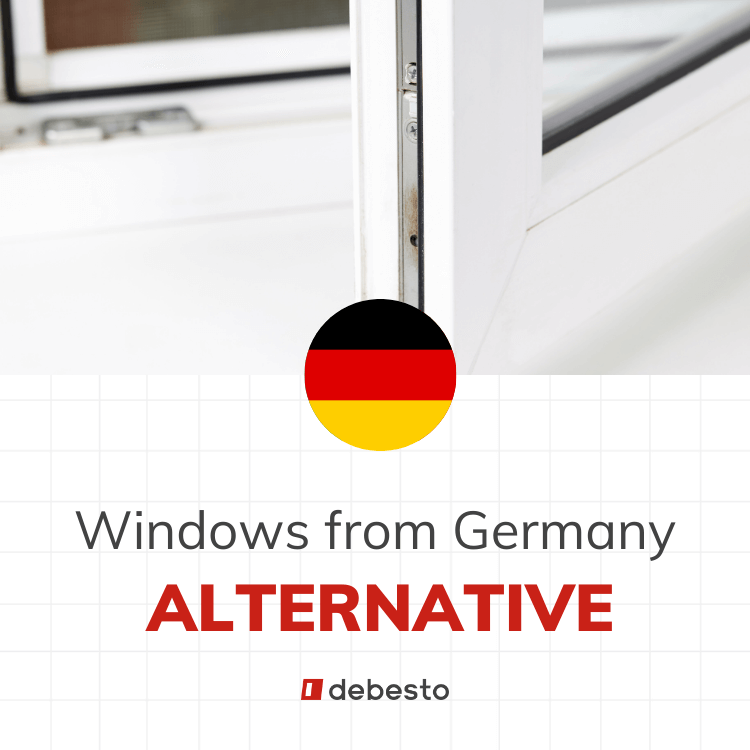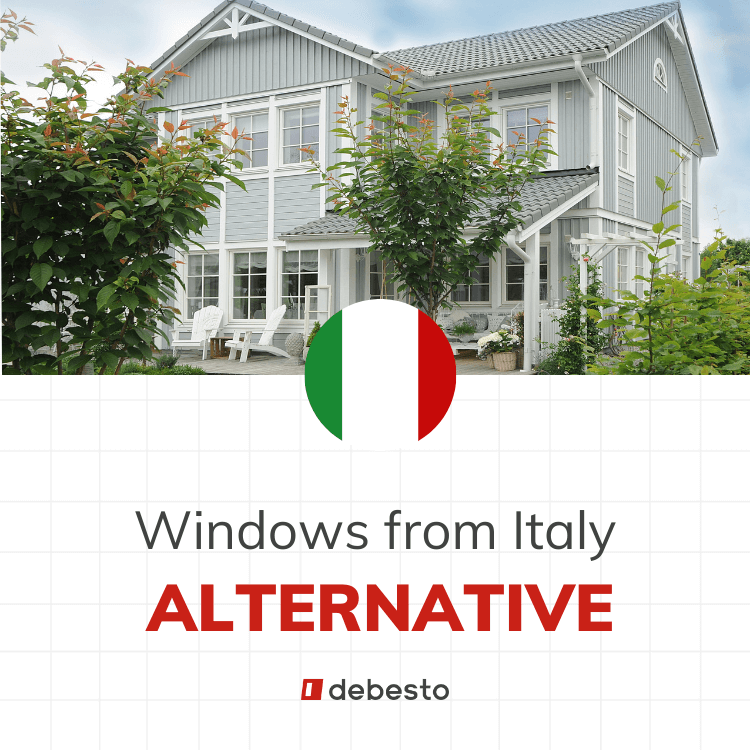Window specifications: Differences between the USA and Europe

How to evaluate the quality of European windows? Classifications and technical parameters should help you better understand window specifications.
However, if you’re familiar with both the European and U.S. markets, you might feel confused by the many technical terms: U-Value or U-Factor? Ug or Uf?
Our guide will help you make sense of the most commonly used parameters.
After reading this article you will know:
- What Uw and U-Value/U-Factor are
- What R-Value is
- What SHGC and VLT are
- Which parameters are used in the European market and which are present in the US market
- How to convert mentioned European parameters into imperial units
- Who sets standards related to fenestration in Europe and the US
Explore more affordable alternatives to U.S. windows
We offer quality European windows made by the best Polish manufacturers. Check out our solutions:


Heat-related specifications
U-Value/U-Factor (both terms are used interchangeably) – the lower the value, the better the window insulates heat. The size of the glazing plays a big role in lower U-Factor results, so profiles with a larger glazing area achieve better performances.
What is the U-Factor exactly? U-Factor determines how much heat is able to pass through 1 ft² of the flat surface of a window when the difference in air temperature inside and outside the room is 1 Fahrenheit. U-Factor is expressed in BTU per square meter per hour per 1 Fahrenheit (Btu/(h⋅ft² ⋅°F).
Its equivalent in the metric system is Uw. It is expressed in Watts per square meter per Kelvin (W/m²⋅K).
Uw consists of the Ug (thermal transmittance of the glass) and Uf (thermal transmittance of the frame), which indicate how much heat escapes through the glazing unit and the window frame. Their area share is multiplied by the total area of the window to get the Uw which is most commonly used in the window specifications.
However, the Uw value is also affected by additional factors, such as the use of a warm edge spacer in the glazing packages, or additional insulators in the frames.
What if only European Uw values are given in the window specification?
It’s simple! You can get the U-Factor by the American scale by dividing Uw, e.g. 1.2, by 5.678, which in this case equals U-Factor 0.21.
Use our converter to quickly change metric U-Value into Imperial U-Factor
Explore examples of European windows that meet U.S. standards
See how we can help you
- Import European windows to the USA directly from Poland
- Save up to 50% on premium-quality windows
- Add value to your custom project
- Stop wasting time – simplify the process
Explore solutions:

U-Factor windows and the US climate
According to the recommendations of the international ENERGY STAR® program, the following U-Factor values are recommended in the States depending on the assigned zones:



R-Value heat resistance coefficient – with a higher R-Value, the window’s resistance to heat flow increases, and thus the structure is a better thermal insulator. The recommended R-Value for a window is usually higher than 5, but you don’t have to worry since the R-Value of triple-glazed windows available on the market is usually around 3-5.
What is R-Value exactly? R-Value is a measure of an insulating material’s thermal resistance, therefore, it is estimated by the ratio of a given material’s layer thickness to its thermal conductivity λ.
What is the difference between U-Factor and R-Value?
Both values are used to determine a window’s thermal performance and are the mathematical reciprocals of each other, but U-Factor uses scientific calculations to measure the level of heat transfer through a window, and R-Value measures the insulation capacity of a particular material and its ability to reduce heat transfer

Window specifications related to light and solar energy
Solar Heat Gain Coefficient (SHGC) – here, the choice of the window depends on the location of your investment – a window with a high SHGC index is more effective in collecting solar heat in the winter, and a profile with a low SHGC is more effective in reducing the heating of the room by the sun in the summer.
What is SHGC exactly?
Solar Heat Gain Coefficient specifies the transmittance of the sun’s energy through the entire window (note that the European g-factor takes into account only the glazing and therefore SHGC is not its equivalent). This coefficient represents the fraction of solar radiation that can be transmitted through or absorbed by the window. It gives an idea of the window’s performance in terms of the amount of solar heat and sunlight that will enter your room.

Another light-related parameter found in the U.S. market is
Visible Light Transmission (VLT),
which is a measure of the amount of visible light coming through a window. This measurement is not expressed in percentage, but is a rating between 0 and 1, with 0 blocking visible light and 1 allowing all visible light into the room.

Europe, however, uses G-Value, sometimes also called G-Factor or Solar Factor, this coefficient determines how much solar energy will enter the room through the glass and heat the area. The G-Value of Polish windows is approx. 50-55% in accordance with WT 2021.
What is G-Value exactly? The G-Value is the ratio of total energy transmittance to incident solar energy on a given partition.
Another parameter used in Europe is Light Transmittance (Lt) – the higher its value, the more light enters the room. Current windows should have a Lt of 70-75%, but it is also possible to choose a profile with specially tinted glass, which will let less light through and reduce interior overheating.
What is Lt exactly? This coefficient indicates how much natural light is let through the glass into the interior. Lt largely depends on the thickness of the glass and its type. It is also worth noting that, for example, for a window on the north and south sides of a house, one usually has different expectations regarding light transmission.
Sound-related window specifications
Weighted Sound Reduction Index (Rw) – the higher the Rw, the better the noise insulation of the window is. Rw is expressed in decibels and used in both Europe and the USA.
The glazing unit plays the greatest role in soundproofing, with layered glass being the best insulator, but the material, type of frame and careful installation are also important. To increase noise reduction, you can use soundproofing tapes or foam insulation.

Another specification used in the US is Sound Transmission Class, which is an integer that indicates how well a window attenuates airborne sounds.

Window specifications related to air permeability and waterproofness
Air Leakage (AL)
– this parameter is measured on a scale from 0.1 (best airtightness) to 0.3.
What is air permeability exactly? It determines the amount of air that gets through the gaps in the window. Air Leakage is calculated by measuring the amount of air (in cubic feet) that can pass through a window per minute, and then dividing that amount by the total area of the window.

In Europe, the UNE-EN-1026 standard divides air permeability into classes 1-4, where 4 is the most airtight construction, it provides more heat in the room, but at the same time makes ventilation harder. European manufacturers usually offer windows categorized in classes 3-4.

In the US, Water Penetration Resistance (also called Watertightness) is expressed in psf (per square foot), it defines the highest allowable pressure caused by water that a window can withstand.
More details about this clasification can be found on the official website of the Fenestration and Glazing Industry Alliance.

The European standard EN 12208 specifies 10 classes of watertightness, from the least watertight class 1A to class 9A along with the special class EXXXX (the pressure value is entered in place of X). Windows from class 1A-A3 are practically non-waterproof, for this reason, Polish windows are usually categorized as 4A-9A or EXXXX.
What is the watertightness of windows exactly? The watertightness of a window determines at what liquid load water will begin to penetrate the structure.
The durability of the window is tested in a laboratory, the strength and speed of the wind to which the window is exposed during the test is also an important factor. In European norms, this resistance is expressed in Pa (Pa conveys the pressure used for the particular test), for illustration, a class 9A window is subjected to a test pressure of 600 Pa and a wind speed of 115 km/h for 5 minutes.

Should spec home developers consider windows with European specifications?
When building spec homes, you need to control costs but still offer quality that sells. European windows let you save 50% compared to premium U.S. windows while increasing property value. Unique windows from Europe offer:
- 50% lower price than premium U.S. windows
- Higher quality – better window materials and specifications
- More design flexibility – custom sizes, colors, and high-end materials
- Fully compliant with U.S. building codes and NFRC standards
Competitive pricing and full compliance with U.S. regulations make European windows an attractive choice for spec home developers who want to cut costs without compromising quality.
debesto makes sourcing these windows simple and hassle-free.y How we help:
- Increase your profit margins thanks to business and product consultation
- On-site delivery – we organize shipping for you, hassle-free
- Reliable lead times – avoid delays and meet deadlines
- Straightforward ordering process – no unnecessary emails or calls
- Enhance your brand’s reputation with superior products
- Support in your time zone – available until 4 p.m. EST (contact us)
What is NFRC?
Have you ever caught yourself removing an NFRC sticker from a construction product and wondered what is the point in all of those numbers?
Now you don’t have to worry about it anymore since you know the basics! Above all, this knowledge will save you and your customer from potential problems resulting from the purchase of windows with specs that are not suitable for a given building, state or climate zone.
Learn more about NFRC-certified windows (made in Europe)


Do you still have doubts about window specifications?
Contact us and consult your project for free.
Get in touch with usYou may be also interested in:










